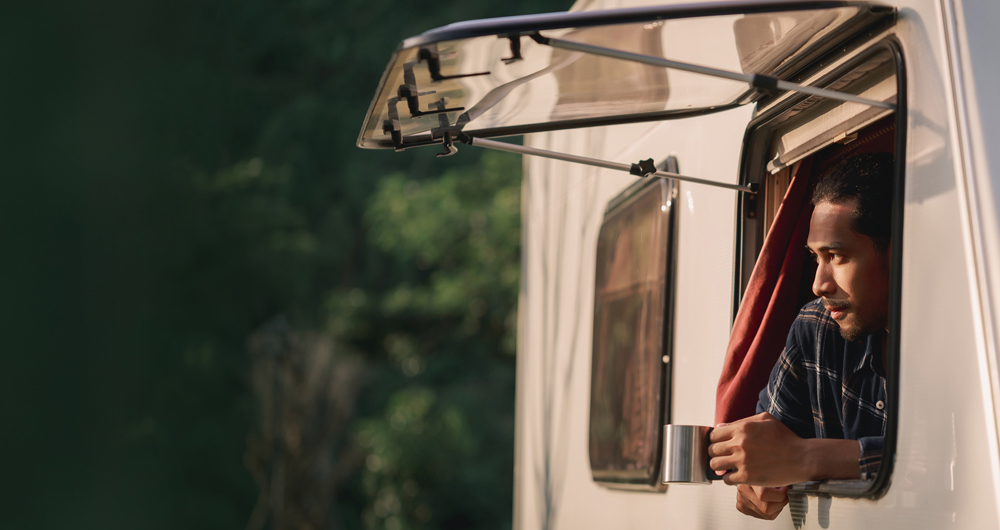INSURING THE MODERN-DAY NOMAD
Are people living “on the road” protected? Do insurers know what they are protecting?
By Joseph S. Harrington, CPCU
In the Academy Award-winning film Nomadland, viewers see a grim but uplifting view of older Americans living as nomads out of their vehicles, with no fixed residence. While the focus of the film is on people left behind by economic transformations, the emergence of modern-day nomadism is by no means limited to displaced workers.
A semi-nomadic lifestyle is also being embraced by highly-educated, highly-skilled young people forging a new future of mobility. Today’s equivalent of hippies in a micro-bus are technology-enabled workers operating out of well-equipped vehicles and hotel rooms, or taking temporary jobs and living in temporary residences.
Facing sky-high housing costs in key markets, many young professionals maintain their parents’ address as their own official address for voting, taxes, bank accounts, and other official purposes, but may spend little or no time there. The trend was given a boost by the Covid-19 pandemic, which shut down offices and left solitary travel as one of the few diversions left to young people.
“An adventure undertaken to build assets for life can, without liability insurance protection, result in a financial burden for many years.”
MBO Partners, a workforce consultancy, defines “digital nomads” as “people who choose to embrace a location-independent, technology-enabled lifestyle that allows them to travel and work remotely.” The firm estimates that nearly 11 million Americans identified as digital nomads in 2020, a nearly 50% increase since 2019.
In response to that growth, a vigorous market is emerging for providing nomads with health insurance. Risk and insurance professionals can see other problems, however, specifically:
- Living for an extended period away from insured premises can jeopardize property coverage under a homeowners or a renters policy
- Coverage for legal liability arising from non-owned premises depends on whether use of those premises falls within a policy’s definition of “insured location”
- Living out of a vehicle (unless it’s a registered RV) does typically not allow for non-auto personal liability coverage as provided under a renters or homeowners policy
- Using a vehicle as a residence can void a personal auto policy, or at least the first-party coverage provided under it
It’s worth noting that many modern nomads keep dogs as companions. Thus, the nomadic lifestyle often encompasses the two leading causes of personal liability claims: motor vehicles and canines.
Assets at risk
While most of the real-life characters in Nomadland are down on their luck, some have voluntarily embraced the lifestyle and some, no doubt, have at least a small amount of financial assets to help sustain them. This means that even those portrayed in Nomadland may have something at risk in the event they are liable for injury or damage to someone else.
Do you think it’s far-fetched that they would be sued? Well, what would you do if you were injured or your four-wheeled residence were damaged by someone you knew had money for restitution?
The stakes are even greater for adventuresome young professionals who temporarily embrace a nomadic lifestyle to save money while indulging their lust for travel. They are not a demographic that elicits sympathy, and any damage or injury they cause can easily be portrayed as reckless behavior born of a sense of entitlement. An adventure undertaken to build assets for life can, without liability insurance protection, result in a financial burden for many years.
There is little producers on their own can do to address the coverage gaps or unintended exposures created by modern nomadism.
Even if property and liability policies were widely available to address the exposure, there would likely be too little premium at stake to merit much in the way of marketing the coverage. The best that most personal lines agents and brokers can do is to ensure that all family members in prized accounts are protected by personal liability coverage tied to a specific address and policy.
It’s also safe to say that producers should brace themselves for some unpleasant discussions with insurers.
Carriers will not be happy with claims that seem very remote from what was intended to be covered by a renters, homeowners, or personal umbrella policy. For example, a carrier will be chagrined to learn that a thirty-something insured as a resident of his parents’ household severely injured someone while mountain-biking in a national forest where he in fact lives 10 months of the year.
It’s always hard for insurers to deny liability coverage, but they will look long and hard for an indication of material misrepresentation of a risk. In the future, they will be more vigilant to determine that the coverage provided really reflects the risk being assumed.
Nomads, beware—and godspeed.
The author
Joseph S. Harrington, CPCU, is an independent business writer specializing in property and casualty insurance coverages and operations. For 21 years, Joe was the communications director for the American Association of Insurance Services (AAIS), a P-C advisory organization. Prior to that, Joe worked in journalism and as a reporter and editor in financial services.





